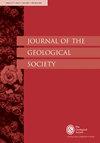Deconstruction of the Franciscan Complex central terrane mélange and re-evaluation of Franciscan mélanges and architecture of the northwestern San Francisco Bay area, California, USA
IF 2.6
3区 地球科学
Q2 GEOSCIENCES, MULTIDISCIPLINARY
引用次数: 0
Abstract
Various mélange types occur within the Franciscan accretionary Complex of western California. The largest mélange body, called the Central Belt Mélange (or similar names) served earlier as the type example for the orogen-long, subduction channel model. Yet, in the northwestern San Francisco Bay Area, the name does not accurately reflect the geology. The mélange designation was commonly applied where resistant exotic and native blocks of rock are scattered across a relatively smooth terrain. Detailed mapping shows that many blocks experienced post-accretion transport. Aerially large rock masses previously designated as Central Belt Mélange consist of multiple units and less than 30 percent of the tectonostratigraphy is mélange. Weakly metamorphosed sandstone-mudrock broken to dismembered formational units and similarly deformed sandstone-mudrock submarine fan facies dominate the tectonostratigraphy. Subordinate mélanges of the northwestern San Francisco Bay Area are of tectonic or sedimentary origin. The sedimentary bodies represent submarine mass flow deposits. Tectonic mélanges mark Mesozoic subduction zone faults or Cenozoic strike-slip faults. Discriminating among mélange types and their origins, and reconstructing tectonostratigraphic columns for major fault blocks, clarifies the primary accretionary complex architecture and reveals significant along strike variations in the Franciscan subduction accretionary Complex.美国加利福尼亚州旧金山湾区西北部弗朗西斯坎复合中心地层混杂带的解构及弗朗西斯坎混杂带和建筑的重新评估
在加利福尼亚州西部的弗朗西斯坎增生复合体中出现了各种类型的熔岩。最大的混合岩体被称为 "中央带混合岩体"(或类似名称),是造山带-长俯冲通道模型的典型范例。然而,在旧金山湾区西北部,这一名称并不能准确反映地质情况。在抗性外来岩块和原生岩块散布在相对平缓的地形上时,通常会使用 "混杂岩 "这一名称。详细的测绘显示,许多岩块都经历了成岩后的搬运。之前被命名为中央带混合岩层的大型岩块由多个单元组成,混合岩层占构造地层的比例不到 30%。构造地层中主要为弱变质砂岩-泥岩破碎至肢解形成单元和类似变形的砂岩-泥岩海底扇面。旧金山湾区西北部的次级混杂岩是构造或沉积成因。沉积体代表海底大规模流沉积。构造岩层是中生代俯冲带断层或新生代走向滑动断层的标志。通过区分蜕变类型及其起源,以及重建主要断层块的构造地层柱,可以明确主要的增生复合体结构,并揭示弗朗西斯坎俯冲增生复合体沿走向的显著变化。
本文章由计算机程序翻译,如有差异,请以英文原文为准。
求助全文
约1分钟内获得全文
求助全文
来源期刊

Journal of the Geological Society
地学-地球科学综合
CiteScore
6.00
自引率
3.70%
发文量
68
审稿时长
6-12 weeks
期刊介绍:
Journal of the Geological Society (JGS) is owned and published by the Geological Society of London.
JGS publishes topical, high-quality recent research across the full range of Earth Sciences. Papers are interdisciplinary in nature and emphasize the development of an understanding of fundamental geological processes. Broad interest articles that refer to regional studies, but which extend beyond their geographical context are also welcomed.
Each year JGS presents the ‘JGS Early Career Award'' for papers published in the journal, which rewards the writing of well-written, exciting papers from early career geologists.
The journal publishes research and invited review articles, discussion papers and thematic sets.
 求助内容:
求助内容: 应助结果提醒方式:
应助结果提醒方式:


